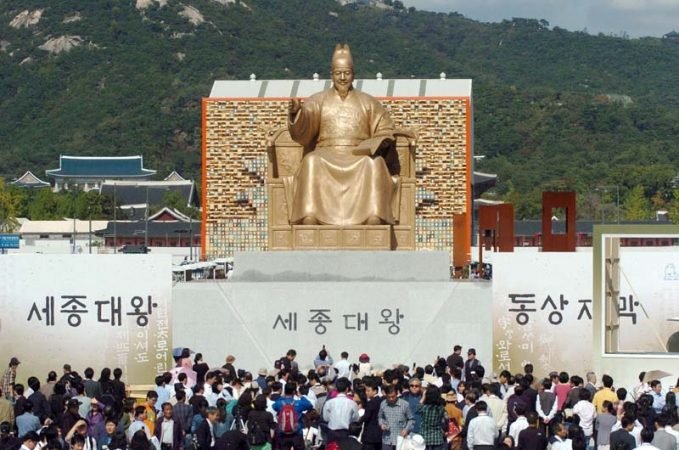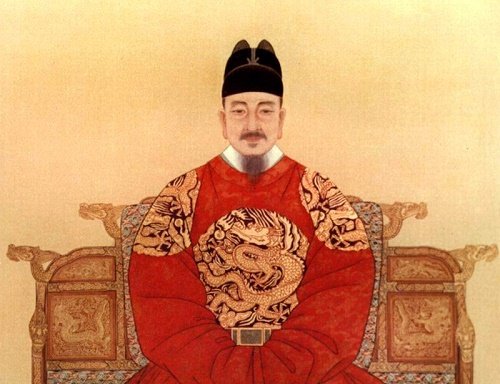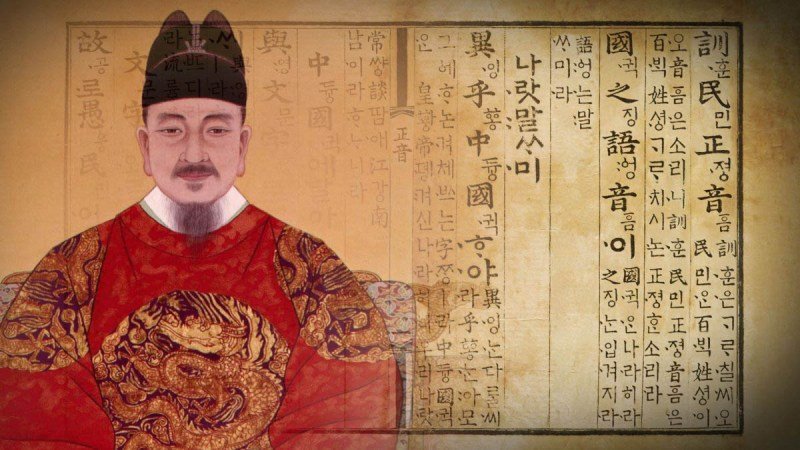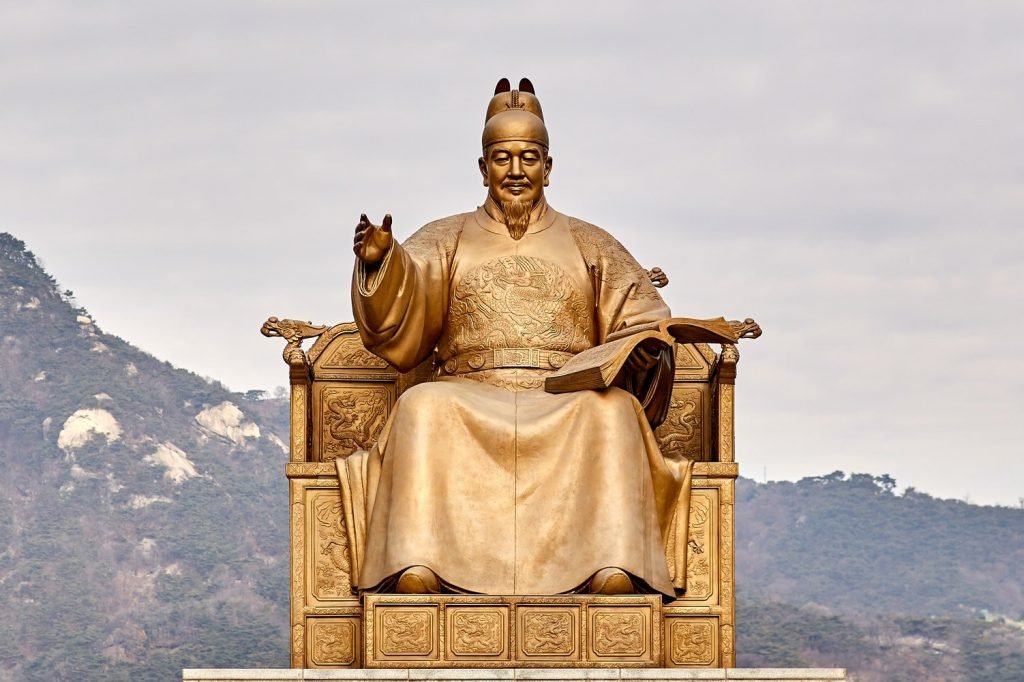Alphabet’s Epitome: The Invention of Hangul and its Contribution to the Korean Society

“In its simplicity, efficiency and elegance, this alphabet is the alphabet’s epitome, a star among the alphabets, a national treasure for Koreans” – John Man
Every year October 9 is celebrated as Hangul Day. The invention of the Korean alphabet or Hangul (coined by Chu Sigyong)is considered as one of the greatest legacies of King Sejong the Great. Hangul has not just crafted an independent identity for the Korean people but has also contributed immensely to their socioeconomic development.
Early Writing System
Literacy in Korea is dated back to the period of the Four Han Commanderies (c.2nd century BCE to 3rd century CE), the first evidence of which is recorded in the inscription at the grand monument of Kwanggaet’o Stela (c.414 CE). The 1800 characters text is entirely in Chinese and sets the tone for the dominance of the ideographic-pictographic Chinese script for more than 1500 years to come, making Korea one of the first eastern states to acquire literacy in the Chinese language. Spoken Korean was thus, written in Chinese characters which came to be known as Hanja (Buzo:1980)
Geographically separated from West and South Asia, the societies of East Asia developed in close vicinity of Chinese cultural influence. With its remarkable economic and cultural achievements, China was “the centre of the East Asian World” (Fairbank:1968) to which Korea was no exception. Korea,in fact, was considered a “model Confucian state” and by a policy of sadae juchii considered China its elder brother, following the Confucian terminology, which explains the dominance of Chinese culture over it (Seth:2011).
However, the Koreans were faced with several problems in the adoption of the Chinese script as the two languages belong to different linguistic families. The Chinese script could not efficiently represent the complex sound system of spoken Korean and the syllabic expression of the sound system in the two languages differed greatly. Moreover, the grammar was entirely different. While Korean is an inflectional language i.e. it gets modified as per the subject, etc., Chinese language as a non-inflectional language is qualified by particles (Kim:2006)
To resolve these problems, the Chinese script was applied to the Korean language to accomplish specific tasks, if not abstractly, which resulted in three forms of early writing systems, idu, hyangch’al and kugyol. While all three share certain core principles such as affinity to the Chinese language, they have functional differences. While Idu was used for prose transcription and Hyangch’al for lyric transcription, Kugyol was used for transcription and translation or interpretation of Chinese Buddhist and Confucian texts (Buzo:1980). However, it did not resolve the fundamental difference between the two languages and literacy remained constrained to a few upper class men.
Invention of the Korean Alphabet
King Sejong the Great, the fourth monarch of the Yi or Choson Dynasty of Korea ascended the throne in 1418. Being a man of high calibre, Sejong was quick to recognise the creative barrier that the use of Hanja placed on Korean intellect. He noted “The speech sounds of our nation are different from China and are not confluent in writing…there are many among the ordinary peasants who, when they have something they wish to say, are ultimately unable to express their meaning” (Sejong qtd.Kim:2006).
In order to achieve his cherished goal of universal literacy, Sejong invented a set of 28 phonetic alphabets in 1443 in the 12th month of his 25th regnal year, which was later published together with a manual in 1446 in the Hunmin Chongum (‘The Proper Sounds of Instructing the People’) (Kim-Renaud:2000). The Hunmin Chongum consists of 33 pages with 4 introductory paragraphs written by Sejong and the rest by the Chipyonjon scholars. The original version, which was lost for almost 500 years, was miraculously discovered in 1940 and in 1997, was added to UNESCO’s list of the “Memory of the World” (Kim:2006).

Sejong’s competence as an expert linguist and phonetician is reflected in his logical depiction of the Korean alphabet. According to the Explanations and Examples of the Hunmin Chongum (Hunmin Chongum Haerye), the basic consonant symbols were schematic drawings of the human speech organs as they articulate certain sounds, while the other consonants were formed by adding strokes to these five basic shapes.
- The velar ㄱ (Khiyak) depicts the root of the tongue blocking the throat
- The alveolar ㄴ(Niyan) depicts the outline of the tongue touching the upper palate
- The labial ㅁ (Miyam) depicts the outline of the mouth
- The dental ㅅ (Shiyat) depicts the outline of the incisor
- The laryngeal ㅇ (Zero initial) depicts the outline of the throat
The pronunciation of the Aspirated Khiyak ㅋ is more forceful than the Khiyak ㄱ and hence, a stroke is added. This principle of kahoek is explained in the Haerye. The text clearly explains the design principles of all letter shapes and their usage. Consonantal forms are iconic as they are either a depiction of articulatory activity or the symbolic representation of the place of articulation in the case of consonants. For instance, all apical sounds (pronounced at the tip of the tongue) contain the basic graphic shape ㄴ, representing the tongue touching the alveolar ridge such as ㄴ, ㄷ, ㅌ, ㄸ, ㄹ(Kim-Renaud:2000)
The vowels depict the fundamentals of the Eastern cosmic philosophy.
- The round dot represents Heaven
- The flat ㅡ represents Earth
- The upright ㅣ represents Man
These three basic shapes are combined to form the other Simple and Complex vowels which as follows: 아,야,어,여,오,요,우,유,으,이,애,얘,에,예,와,왜,외,워,웨,위,의.
The vowel symbols are completely distinct from consonants to represent contrasting sounds. While consonants can be made by adding strokes based on sound, this process does not apply to vowels since consonantal points of articulation are easier to identify due to oral contact, a phenomenon absent in vowels.
The consonants and vowels each represent a phoneme or unit of speech and together the letters make a syllable. For instance, “Money” in Korean is “돈” which is formed by ㄷ(consonant)+ㅗ(vowel)+ㄴ(consonant). Similarly, the Korean word for “Spring”, 봄, is formed by a combination of ㅂ(consonant)+ㅗ(vowel)+ㅁ(consonant).
Confucian philosophy is ensconced at the core of the Korean alphabet. Each vowel and consonant is either described as representing yin (feminine,passive,dark,dry and cold) or yang (masculine,active,bright,humid and hot). As in Confucain beliefs, the interaction between these two principles give rise to the Five elements i.e. wood, fire, earth, metal and water, which are represented by the five basic consonants, according to their place of articulation (Kim:2006). Vowel symbols are thus logically arranged as mirror images where the ones representing yang are represented by sky/heaven above the earth or right of human while the yin vowels are depicted as sky/heaven under the earth or on the left of the human (Kim-Renaud:2000)
What distinguishes Hangul from other alphabetical scripts and makes it more akin to East Asian languages is how it is written in syllable block such as in “달” (Moon), ㄷ (consonant)+ ㅏ(vowel) is written on top while ㄹ (consonant) is placed at the bottom (Kim-Renaud:2000)
According to Ki-Moon Lee and S.Robert Ramsey, one of the major purposes of the new alphabet was to correct the pronunciation of the Chinese characters. Thus,Sejong constituted a committee which produced a six volume dictionary of Chinese characters as an official standard for Sino-Korean pronunciation called Tongguk Chongun(‘The Correct Rimes of the Eastern Country’). It was later distributed to schools once finished in 1447 (Lee and Ramsey:2011).
King Sejong’s new invention was not free from opposition. His ideas of spreading literacy to all subjects ruffled many feathers in the royal court. At the forefront of this opposition were the upper class men such as the Scholar Literati (Lee and Ramsey:2011). A senior scholar of the Chipyonjon, Choi Manli, fiercely criticised the new alphabet by stating that moving away from the Chinese script would confer on the Koreans the status of ‘barbarians’ “similar to the Mongols,Jurchens, Sohana, Japanese and Tibetans” (Kim:2006). Sejong dealt with such opposition prudently and continued to promote his invention. Several literary works such as the Songs of Flying Dragons, the first text to be ever written in the new alphabet; Detailed Articles on the Record of Sakyamuni and the Songs of the Moon’s Reflection on Thousand Rivers (Lee and Ramsey:2011). Sejong issued his royal ordinances in both Chinese script and Korean alphabets. Public notices for the common people began to be published in the new alphabet, which also became a compulsory topic for the Civil Services Examination (Kim:2006). However, the Scholar officials and Literati continued to use Hanja for official and unofficial purposes for the next 400 years (Kim:2006).

Influence of the Korean alphabet on Korean culture
One of the most remarkable contributions of the Korean alphabet was to promote literacy in Korea. Gari Ledyard notes that during Sejong’s time, the concept of literacy was strictly limited to the ability to read hanmin or Classical literary Chinese. Sejong broadened this definition from the mere ability to read hanmin to the ability to read and write the transcription of what was actually spoken by Koreans through the new alphabet. The invention of the Korean alphabet hence was not just a reform but a “linguistic coup d’état”. His vision of literacy was much more creative for it focused on a more active way of expressing one’s ideas in writing rather than passive reading oriented literacy of the Hanja (Kim-Renaud:2000). It was because of this logic oriented, rational and yet easy to learn alphabet that a wider population including women and poor people could learn to read and write
The invention of the Korean alphabet also led to the literary efflorescence in Korea. Before the invention of the Korean alphabet, Chinese literature dominated Korea. Korean writers and poets such as Yun Sondong and Kim Sujang continued the use of Chinese characters in a unique Korean style of poetry called sijo. Other than the literary works noted above, many more began to be written. The Story of Hong Kiltong by Ho Kyun (1569-1618) was the first novel to be ever written in Hangul. Kim Manjung’s The Cloud Dream of the Nine wasbased on the Buddhist idea of dreams and clouds that hide reality. Both novels dealt with the conflict between pretense and reality of elite lifestyle. Though educated elite men avoided writing in the new alphabet, its knowledge promoted many women, particularly the court ladies, to write their memoirs. As these were not meant for publication, they contain many secrets which serve as a great historical source and are literary marvels. The Tale of Queen Inhyon and The Memoirs of Lady Hyegyong are a few examples. In the wake of modernisation, many new themes such as the conflict between tradition and modernity became central to novels such as Yi Injik’s Tears of Blood and Yi Kwangsu’s The Heartless. Ch’ae Mansik’s Peace Under Heaven (1937)recorded the plight of Koreans under Japanese rule. With higher literacy rates, readership also increased (Clark:2000).
A great contribution of the Korean alphabet is that it gave an independent voice to the Korean people who had lived under Chinese cultural dominance for several hundred years. For a smaller state like Korea, it was a bold move to sway away from the use of Chinese characters to a new alphabet keeping their prestige at risk, as reflected from the statement of Sejong’s official Choi Manli. However, Sejong was keen on developing a more logical and easily comprehensible writing system for a wider population which crafted a unique cultural identity of the Korean people and enabled them to walk out of the shadow of Chinese hegemony. It is neither based on ancient written languages nor an imitation of some other alphabets but a writing system truly indigenous to Korea. Following the Treaty of Shimonoseki (1895) as Korea became free from the dominance of China, the movement for language purification grew. Many nationalists such as Chu Sigyong called for ‘purifying’ Korean script of all Chinese influences and hence coined the term Hangul (한글) in 1912 which translates to “Korean writing”. Importance of Hangul resurfaced as the Japanese colonial government enforced the policy of forceful acculturation called Naeson Ilche by suppressing all symbols of Korean identity including language. The use of Hangul thus became a form of patriotic resistance. The Independent emerged as the first Hangul-only newspaper and published editorials calling for the promotion of Hangul and resistance to imperialism(Seth:2011).
The phonetic nature of modern Hangul also gives it a cosmopolitan character since many words including those of Western languages can easily be understood and written in it. For instance, the word for “Canada” can be directly written as “캐나다”. Similarly, “Europe” can be written as “유럽”. It is not possible to do so in non alphabetical languages such as Chinese which either have a Chinese word or transliteration for Western words.
The invention of Hangul has also brought prestige to Korea. Linguists such as S.Robert Ramsey, John Man, Geoffrey Sampson, Gari Ledyard among others consider it an “unparalleled grammatological luxury” for the “strict correspondence it shows between graphic shape and graphic functions” (Ledyard qtd. Kim:2006). They regard it as “alphabet’s epitome” for it not only clearly distinguishes within and between vowels and consonants but also is “far along the road towards perfection as any alphabet is likely to get” (Sampson qtd. Kim:2006). Scholars consider its articulation within a few years as compared to hundreds of years of adaptation and development of other writing systems as one of the greatest intellectual achievements of humankind (Kim:2006). Its invention also counters the Occidental narrative of Asian societies being ‘stagnant’ and of their ‘inability to develop’.

The relatively simple and logical Hangul is one of the reasons behind the success of Hallyu or the Korean Wave which greatly adds to the economy and soft power diplomacy of South Korea. It is comparatively easier for foreigners to learn which creates a huge market for the Korean entertainment industry as well as education sector as many foreign students flock to Korea to pursue their higher studies. It also enhances knowledge about Korean history and culture enhancing its soft power or global cultural value. Even as grave socioeconomic and political differences exist with North Korea, it is Hangul that binds the two nations together and creates greater possibilities for future dialogue such as the Sunshine Policy.
Several scholars have called Hangul the “alphabet of the 21st century“, attributing Korea’s economic success in the Age of Information technology to the easily written Hangul. They write that in a computer keyboard, Korean vowels are arranged on the right while consonants are arranged on the left which make it easier to type alternatively and is less tiring than typing, for instance, Chinese which is typed through Roman characters. With Hangul, as the sound changes, the frequency also changes at a fixed rate which makes speech recognition easier and faster (Kim:2006)
Many scholars regard Hangul as Korea’s spiritual heritage to be shared with the world as it’s phonetic characteristic makes it suitable to be used as an alternative alphabet for minority people who do not have a written script for their spoken languages thus, preserving loss of rich linguistic heritage.
Sejong’s efforts and the rich heritage of Hangul have been widely recognised by both the South Korean government and the international community. The Korean government has declared October 9 as Hangul Day. UNESCO created the King Sejong Literacy Prize in 1989 as part of the worldwide campaign to eradicate poverty.
As noted the invention of the Korean alphabet is not just one of the greatest intellectual achievements of a state regarded as a ‘stagnant’ ‘hermit kingdom’ by the Occidental narrative but its ability to express different languages especially those without a written script serve as a boon to the preservation of global intangible heritage. The story of its invention also serves as a lesson for leaders of the present and future. King Sejong built his greatness not by unsheathing his sword but by giving his people a new identity of their own. His contribution helped in making Korea,in the words of Rabindranath Tagore, “The Lamp of the East”.
Bibliography
- Buzo,Adrian. ‘An Introduction to Early Korean Writing Systems’. Transactions of the Royal Asiatic Society: Korea Branch. Volume 55,1980. pp 35-61
- Diamond Sutra Recitation Group.King Sejong the Great: The Everlasting Light of Korea. Kim Jae-Woong,2006
- Kim-Renaud,Young-Key. ‘Sejong’s Theory of Literacy and Writing’. Studies in the Linguistic Sciences. Volume 30,Number 1,Spring 2000
- Lee, Ki-Moon and S. Robert Ramsey. A History of the Korean Language. New York: Cambridge University Press,2011
- Seth, Michael J. A History of Korea: From Antiquity to the Present. UK: Rowman & Littlefield,2011
- Clark, Donald N. Culture and Customs of Korea. US: Greenwood Press, 2000
- Fairbank,John King (ed.) The Chinese World Order: China’s Foreign Relations.Massachusetts: Harvard University Press,1968


















